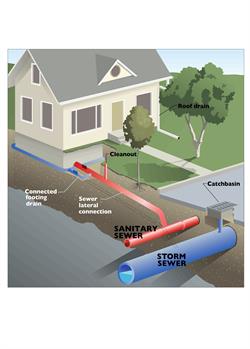
If you have a wet basement, experienced backups, or have been contacted by a developer about disconnecting your "footing drain", allow us to explain what may be going on.
Over many decades, many structures in Ann Arbor were built with footing drains, pipes installed around or beneath a structure to collect then direct stormwater away. Unfortunately these were then connected directly to the sanitary sewer system, therefore mixing storm and sewer water. Later, code even allowed the use of sump pumps, or similar systems, to pump water from footing drains into the sewer as well.
What's the problem with my footing drain connecting to the sewer?
Large storms or heavy rain can cause a massive flow of stormwater, sometimes 10-20 times normal, into sanitary sewer pipes, through these connected footing drains.
The extra flow can temporarily exceed the system’s capacity, which can result in overwhelming the sewer treatment plant and/or basement backups.
A number of times during the 1980s, 1990s and early 2000s, large rainstorms caused the sanitary sewer system to exceed capacity, causing sewage to back up in homes in some neighborhoods.
Development, such as the construction of new buildings and homes, increases the burden on the sanitary sewer system.
What can we do to fix the problem?
Removing a building’s connected footing drains through the Developer Offset Mitigation (DOM) program can:
- Reduce the amount of stormwater entering the sanitary sewer system
- Reduce overall flow in the sanitary system improves it's capacity
- Reduce the chance of sanitary sewer overflows and basement backups
- Reduce unnecessary treatment of stormwater
The City also has a set of program guidelines (PDF) for developers engage in this program.
Frequently Asked Questions
Q. How much does an FDD cost?
A. Homeowners negotiate and contract directly with the developer and contractor to have the work performed at no or reduced cost to the property owner.
Q. Who can disconnect my footing drains and install a sump pump?
A. A licensed contractor can perform the FDD and install a sump pump and discharge system.
Q. Will my FDD and sump pump installation include a backup system?
A. Installing a backup system is strongly recommended, but entirely optional. Property owners are encouraged to negotiate the installation of a backup system as part of the work to be completed. We have information
online regarding basements and sump pumps.
Q. Where will the sump pump be installed?
A. The sump pump should be installed at the lowest point of the basement. Alternate locations can create risks of flooding from the sump pit. To effectively collect groundwater, direct it to a sump pit, and pump the groundwater away from the structure, disconnections must begin at the footing drain tie-in to the sanitary, and be re-directed to the sump location by trenching or tunneling.
Q. Who is responsible for maintaining the sump pump in the future?
A. The property owner is responsible for any future maintenance unless they have negotiated that the developer or contractor provide a warranty. The City of Ann Arbor does not maintain or warrant sump pumps or FDDs.
